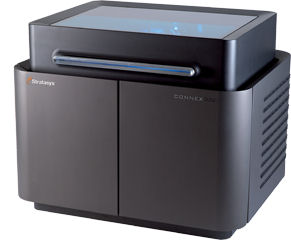Check it Out: PolyJet 3D Printing and the Objet500 Connex
Latest News
May 3, 2013
 |
The other night as I lay multitasking—texting, watching TV, and reading an eBook—the tube suddenly grabbed my uni-tasking attention. I don’t recall what the network show was, Castle or something, but an actor portraying an early grade elementary school teacher asked her students if they knew what 3D printing was, and they all acted as if they did. Well, I think they acted. But, geez, if you ever needed validation that 3D printing is a hot topic, there you have it. Prime time network TV.
Thing is though, many adults also act as if they know what 3D printing is. They have the basic idea—a machine that produces hard copies of a design—but they soon tap out their knowledge base when they venture into printing technologies, materials, capabilities, and potential to disrupt. Understandable; there’s a lot to know. From today’s Check it Out link, “PolyJet 3D Printing and the Objet500 Connex,” you will not become an expert in 3D printing technology, but you will end up with a deep understanding of what an Objet500 Connex 3D printer from Stratasys could mean to your new product design and engineering processes.
The media for the message today comes in four main parts: technology outline, video, a case study, and a white paper. All are online, of digestible size, informative, and thought provoking. Start with the technology outline.
“How PolyJet 3D Printing Works” is a brisk, non-technical overview of the 3D printing technology incorporated in the Objet500 Connex and other Objet-branded systems. To build a part, PolyJet 3D printing technology “ink jets” 16-micron layers of liquid photopolymer onto a build tray and cures it with UV light. Two takeaways from this read: 1) Objet Connex 3D printers can, uniquely, mix different materials in the same 3D part in the same build job and 2) you have a choice of more than 100 materials and material combinations. OK, 3), the analogy to ink jet paper printers makes the additive build process sound straightforward enough.
Next up is the video demonstration of the Objet500 Connex build process. This is really the heart of the matter. Set to non-obnoxious music and without narration, this 2-minute 44-second video puts into motion and elaborates on what you read about in the tech overview. As the part builds and the process progresses, you see an occasional caption explaining, say, key specs, such as thin 0.024-in. (0.6mm) thin walls. (BTW, we’ve linked to the spec sheet for you.) You get close-ups of the part’s surface details so you can see the smoothness of its texture. And you get to see how you physically interact with the system, such as changing material cartridges, removing support materials, and prepping the build tray for a new run.
While the technology synopsis and a video are good, the question, as always, remains: “what’s in it for me?” The answer to that lies in the “Adidas Races to the Future with Objet 3D Printing” case study. The plot line of this short but good item is that this well-known developer of sports footwear, apparel, and accessories was an old-hand at leveraging rapid prototyping for better designs. They were so good at it that in-house demand for more and more prototypes got out of hand. So, the Adidas solution was to upgrade to the Objet500 Connex. Why that model? Because it could make large prototypes (up to 19.3 x 15.4 x 7.9 in.) with finer details in multiple materials (up to 14) in a single job, and it’s faster than their previous system, so everybody is getting their prototypes. And that means that the Objet500 Connex changed the entire Adidas product design process in a big, positive way.
Finally, download the white paper “10 Reasons Why Multi-Material 3D Printing is Better for Your Product Design & Development.” It serves as a deeper explanation of the benefits of Objet’s dual inkjet additive manufacturing technology and its ability to print objects in multiple materials. Of the more than 100 materials available, some 90 of them are composites that provide a range of properties such as rubber-like to hard plastic to high-temperature resistance. This means your prototypes can resemble your hoped-for end product closely. In a nutshell, this 11-page PDF is a darn good closing argument.
You can start building your knowledge base on PolyJet 3D printing technology and the Objet500 Connex 3D printer—ahem—layer-by-layer by hitting the link over there. Also, make sure to notice your surroundings while in the case study area. There are lots of good case studies available. One could be about your competitor.
Thanks, Pal. – Lockwood
Anthony J. Lockwood
Editor at Large, Desktop Engineering
Read “How PolyJet 3D Printing Works.”
Watch the Objet500 Connex in action.
Download the “10 Reasons Why Multi-Material 3D Printing is Better for Your Product Design & Development” white paper.
Subscribe to our FREE magazine, FREE email newsletters or both!
Latest News
About the Author
Anthony J. Lockwood is Digital Engineering’s founding editor. He is now retired. Contact him via [email protected].
Follow DE





